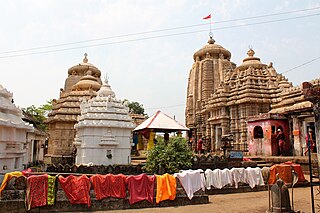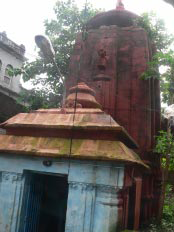Jalesvara Siva Temple Precinct is a Hindu Temple dedicated to Shiva situated on the southern outskirt of the village Kalarahanga at a distance of 2.00 km from Patia and 6.00 km south of Chudangagada in the northern outskirt of Bhubaneswar, Odisha, India. The presiding deity is a Siva-lingam within a circular yonipitha inside the sanctum, which is 1.15 meters below the chandrasila. The sanctum measures 2.00 square meters.
Kalabhairavi Temple is located at Bhubaneswar of Odisha, India within the Jaleswar Siva Temple Precinct, Kalarahanga. The enshrined deity is a four armed Chamunda sitting over a dead body. The deity holds a khatuanga in her upper right hand, a snake in upper left hand, a severed head in lower left hand and the lower right hand is broken. The deity is crowned with jatamukuta and wearing a garland of skull. The whole image rests over a pedestal measuring 0.50 metres in height.

The Kapilesvara temple is a Hindu temple dedicated to Shiva located in the south western outskirt of the village Kapilesvara, Old Town, Bhubaneswar, Odisha, India. It is located at the end of Kapilesvara road leading from Lingaraj temple to Kapilesvara Village. The presiding deity is a Siva-lingam at the center of a circular yonipitha inside the sanctum. It is a living temple, facing towards east and maintained by Kapilesvara Temple Trust Board. The temple is situated within the precinct along with 33 other monuments. The precinct is located on the northern embankment of Manikarnika tank over an area of 44.00 square metres.
Nilakanthesvara Shiva Temple is a temple in Orissa, India, located on the western embankment of the Bindusagar tank. It is situated on the left side of the lane branching from the road leading from Kedar Gouri chowk to the Vaitaḷa deuḷa in Bhubaneswar, the capital state of Orissa. The temple faces east. The temple's enshrining deity is a circular yoni pitha with a chlorite Siva lingam. The temple is made out of sandstone. The present temple is a recent construction over the remains of an earlier one. The building material is old but the entire structure now has cement plaster and an enamel point.

Arjunesvara Siva Temple is a 12th Century A.D. temple in Bhubaneswar, in the state of Orissa, India. The temple is situated on the southern embankment of the Bindusagar tank at a distance of 70 metres and situated on the right side of the ratha road branching from the road leading from Lingaraja temple to Ramesvara temple. The temple is facing towards west.
The Bhringeswara Shiva temple is an 8th century Hindu temple situated on the foothills of Dhauli and the left bank of the Daya River, in the southeastern outskirts of Bhubaneswar(India) in the village Khatuapada. The temple is facing towards west and the presiding deity is a circular yoni pitha with a hole at the centre. The temple is made of light grey sandstone. The temple is renovated one from bottom to the top by employing the earlier materials. This temple is now under the protection of Odisha State Archaeology.

Chintamaniswar Shiva Temple is a Hindu temple dedicated to Lord Shiva in Bhubaneswar, the capital of Odisha, India. It is at the end of the Chintamaniswar road branching from Cuttack-Puri road near the Old Station Bazar. The temple faces west and the enshrined deity is a Siva lingam with a yonipitha.
Patalesvara Siva Temple – I is a temple dedicated to Lord Shiva, located in Old Town, Bhubaneswar, Odisha,India. This temple dates back to 13th century, and belongs to the Ganga era. At present, this temple is situated inside the compound wall of a private residence.
Svapnesvara Siva temple is in Gourinagar, Old Town, Bhubaneswar, the capital of Odisha,India. It is 200 m northeast of Purvesvara Siva temple. The temple is facing east. The 2 m2 sanctum is empty.
The Swarnadhisvara Siva temple is located in the northern side of the road leading from Lingaraj Temple to Kedar Gouri, in Bhubaneswar, the capital of the state of Orissa,India. The temple is facing towards east. The enshrined deity is a Siva lingam within a circular yoni pitha. The Sanctum measures 1.5 square m which is 2 m below the present ground level. The temple is made of laterite. It is an abandoned and a non-living temple. The temple was built in the Late Ganga period in the 13th century.
Siddhesvara Siva Temple is located inside the Kapilesvara temple precinct, Kapilesvara village, Old Town, Bhubaneswar. It was built in the 15th century AD. The temple is facing east and the presiding deity of the temple is a Siva lingam within a circular yonipitha, which is made of laterite. The cella of vimana is measuring 1.55 square m. The temple is made of sandstone and totally renovated one. It is under the care of Kapilesvara Temple Trust Board.
Markandesvara Siva Temple was constructed by Kesaris to commemorate the visit of sage Markandeya, same as the Samesvara Siva temple. It is an abandoned temple and is facing towards the east. However at the center of the sanctum there is a Siva-lingam with the circular Yoni pitha. The temple is totally covered with wild vegetations.
Nilakantha Siva temple is located in the Kharakhia Baidyanatha temple precinct, Kharakhia Vaidyanath Sahi, Old Town, Bhubaneswar. One can approach to this site on the left side of the Vaidyanath road leading from Lingaraja temple to Kapilesvara. This is a living temple and is facing towards the west. The enshrining deity of this temple is a Siva lingam within a circular yoni pitha at the centre of the sanctum sanatorium. The sanctum is 0.77 metres below the chandrasila.
The Somesvara Siva temple is located in the Kharakhia Baidyanath temple precinct in Kharakhia Vaidyanath Sahi, Old Town, of Bhubaneswar. It is located approximately 300 metres south of Lingaraja temple. Visitors may approach the site on the left side of Baidyanath Road leading from Lingaraja temple to Kapilesvar. It is a living temple and faces towards the west. The enshrined deity of this temple is a Siva lingam within a circular yonipitha at the center of the sanctuary located 0.93 metres below the chandrasila. The temple is under the care and maintenance of Babulal Makaddam Badu Mohapatra, the chief priest of the temple, on whose private land the temple stands.
Gangesvara Siva Temple is situated within a precinct on the left side of the Ganges–Yamuna road Old Town, Bhubaneswar, Orissa, India. It is located at a distance of 200 metres north-east of Lingaraj temple, 50 metres north of Lakhesvara temple across the road, 200 metres south of Subarnesvara and 100 metres east of Gourisankar temple. The temple is facing towards east. The presiding deity is a Siva lingam within a circular yonipitha. It is a living temple and maintained by the Ganga YamunaSangathana.
Ladu Baba Temple is a temple in Bhubaneswar, Odisha, India. It was built in the 13th century AD and was formerly known as Kainchhi Temple.

The Tirthesvara Siva temple is a Hindu template located in Bhubaneswar, the capital of Odisha, India.

Mangalesvara Siva Temple is a Hindu temple located in Bhubaneswar, Orissa, India. It is located at Lat- 20◦ 14’ 38" N., Long- 85◦ 50’ 38" E., and at an elevation of 45 ft.
Sarvatresvar Siva Temple is situated on the right side of Mahavir lane branching from Lewis road to Sisupalgarh, Bhubaneswar, Orissa, India. It enshrines a Siva-lingam within a circular yonipitha inside the sanctum. The temple precinct is located on the right bank of the stream Gangua.
Sinduresvara Siva temple is located in village Sundarpada, Old Town, Bhubaneswar, Odisha, India. It is on the right side of the road leading from Lingaraj temple to Sundarpada. The enshrined deity is a circular yonipitha facing towards the north. The Siva lingam decayed in course of time. In April 2013 the villagers raised funds and reestablished new Shiv Linga. There are two entrances on the south-west and northwest corners provided with seven flights of steps leading down to the temple.





